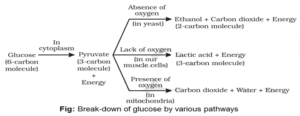RESPIRATION
- The process by which a living being utilizes the food to get energy is called respiration.
- Respiration is an oxidation reaction in which carbohydrate is oxidized to produce energy.
- Mitochondrion is the site of respiration and the energy released is stored in the form of ATP (Adenosine triphosphate). ATP is stored in mitochondria and is released as per need.
STEPS FOR RESPIRATION
(a) Breaking down glucose into pyruvate
This step happens in the cytoplasm. Glucose molecule is broken down into pyruvic acid. Glucose molecule is composed of 6 carbon atoms, while pyruvic acid is composed of 3 carbon atoms.
(b) Fate of Pyruvic Acid:
Further breaking down of pyruvic acid takes place in mitochondria and the molecules formed depend on the type of respiration in a particular organism. Respiration is of two types, viz. aerobic respiration and anaerobic respiration.
BREAKDOWN OF GLUCOSE BY VARIOUS PATHWAY

STORAGE OF ENERGY DURING RESPIRATION
- The energy released during respiration is used to make ATP molecules from ADP molecules and inorganic phosphate.
ADP + Phosphate + Energy ———-> ATP
Adenosine Adenosine
di-phosphate tri-phosphate
- When cells need energy then these ATP molecule further converted into ADP molecules, phosphate and energy.
ATP ——-> ADP + Phosphate + Energy
ANSWER THE FOLLOWING QUESTIONS
- What is respiration ?
- During respiration energy is stored in the form of …………………. in mitochondria.
- Glucose is composed of …………………. atoms and pyruvate is composed with 6 carbon atoms.
- In the absence of oxygen in yeast pyruvic acid is converted in ………………. , …………….. and …………….
